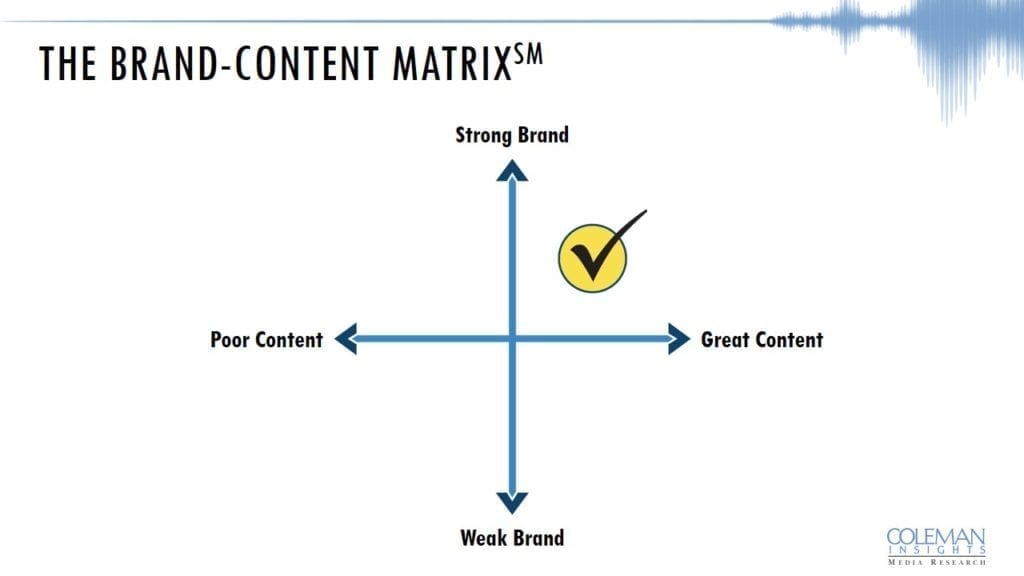
Coleman Insights’ Brand-Content Matrix measures brand and content strength. The goal is to be in the upper right quadrant, at the intersection of strong brand and great content. While we generally share examples of where audio brands fall on the Brand-Content Matrix, today we’ll have a little fun. I’ll demonstrate how this tool can be used to evaluate the brand and content strength of just about anything. Even a vegetable.

Kale is disgusting. It is dry, has a texture so rubbery my car could drive on it, and leaves your mouth with a bitter aftertaste. Mmmmm.
But my opinion isn’t shared by millions who eat kale everyday and think it offers “great content.” It’s become a brand juggernaut in the health food space. But kale didn’t always have a strong brand, and it wasn’t loved for its content either. If kale—kale!—can build a brand and develop strong content, surely your brand can too. Let’s explore how it was done.
First of all, while its popularity may be, kale itself is definitely not new. Kale has been cultivated for over 2,000 years in North America, and the frost-resistant crop dates back to 600 BC when the Celts brought it from Europe to Asia Minor. Legend has it that the largest buyer of kale prior to 2012 was Pizza Hut. They used it as garnish around their salad bars.
But today, kale is found in high priced foods and beverages and is a darling of the health food industry.
Which hipster is responsible for this disaster?
Actually, it may be Martha Stewart’s fault.
Her company’s Whole Living magazine branded kale a “powerfood” in 2008. Then she published a recipe for kale slaw in 2009. The next thing you know, Dr. Oz is talking about kale and thyroids, Gwenyth Paltrow’s making kale chips, and your kale smoothie–natch, “superfood smoothie”—is $8.95.
The rise of kale was pretty handy for the food industry, as you can snag a bunch of it at Walmart for 78 cents. Which I contend is still overpriced.
THE BRANDING AND MARKETING OF KALE
Kale would not and could not have climbed its way up the brand ladder from buffet garnish at the Hut to chic miracle green without some really impressive branding and marketing efforts. Calling it a “superfood” and “power food” is utter genius. Getting the right celebrities behind it powers the engine.
This is how kale’s brand shifted from weak to strong, but it still had a content problem. You may be drawn to try kale thanks to its brand strength, but you won’t try it again if you don’t like it.
An equally brilliant move by the kale brigade was the decision to include kale as a secondary ingredient in so many recipes.
You likely don’t order a kale smoothie—maybe you order a pineapple kale or blueberry kale version. Or something like the Detox Island Green smoothie at Tropical Smoothie Café with spinach, kale, mango, pineapple, banana, and fresh ginger.
Fun fact, I’ve had the Detox Island Green smoothie. It’s delicious. You know why? IT DOESN’T TASTE LIKE KALE!
Fruit masks the flavor of the kale.
So does the spicy sweet potato and avocado sauce in a Southwestern Kale Power Salad.
“Oh, I sauteé kale! It tastes so good!” Maybe that’s because you mix in garlic and bacon.
So you see, the kale squad didn’t just run a master class in branding. They knew the taste of mere kale alone would keep its sad spot in the upper left quadrant of the Brand-Content Matrix (strong brand, poor content.) So close, but yet so far.
Because they figured out how to boost the brand as well as improve the eating experience, it could easily be argued that kale is in fact it its rightful position in the upper right quadrant, with its strong brand and great content.
I can only hope we’re towards the end of this long national nightmare. But in the meantime, I’ll tip my cap to team kale, and take this moment to remind you that there needs to be consistent, deliberate efforts undertaken to build a strong brand. But that is simply not enough.
You better also come to the party with strong content. If your content is mere kale-level, it is incumbent on you to spice it up and make it a superfood.
Finally, let’s toast this branding/content moment with a strawberry-banana smoothie.
You know, what smoothies are supposed to be made of.

I am officially on record as objecting to my colleague’s blog post this week. I LOVE KALE!
Jay,
I love the Detox Island Green too! I have been a Tropical Smoothie regular for a while but always avoided this until recently. I get it with Splenda and soy powder added. Really super.
I will use the analogy of strong brand/weak content to teach my communications students here at Saint Augustine’s. Thanks for the article (or is that old branding?).